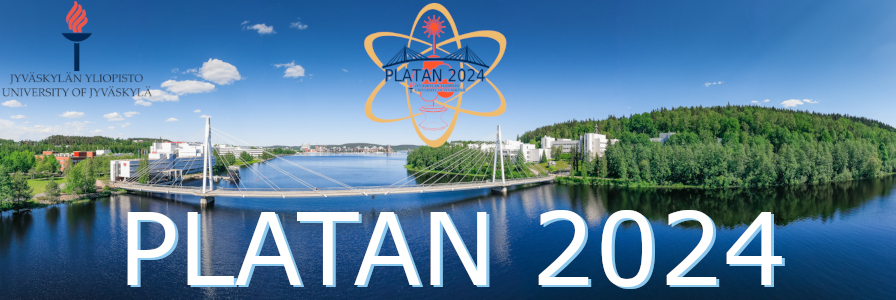Studies of atomic spectra through resonant laser excitation and ionization provide information on nuclear structure. Precise measurements of the hyperfine structure (HFS) give an experimental insight on the nucleus' deformation through the electric quadrupole moments and the single-particle structure through the magnetic dipole moments. However, this method is limited by low production yields and scarce knowledge on the atomic structure [1]. Nevertheless, the measurements of these observable will help to further probe the transition to the macroscopic regime and to calibrate existing nuclear models of heavy nuclei.
This work will discuss the results of our last measurement campaign, where a sample of $^{254}$Es was provided by the Florida State University and the Oak Ridge National Laboratory, USA. This sample was then neutron irradiated in the high-flux research reactor at the Institute Laue-Langevin in Grenoble, France, to obtain $^{255}$Es. After the irradiation, the sample underwent a chemical separation at the Department of Chemistry – TRIGA site at Mainz University, Germany, allowing an iterative separation of the decay daughter $^{255}$Fm.
This process delivered nine samples consisting of $10^8$ to $10^9$ atoms, used to study the atomic and nuclear structure of $^{255}$Fm ($Z=100$) at the RISIKO Mass Separator at Mainz University.
High-resolution spectroscopy was performed using the Perpendicularly Illuminated Laser Ion Source and Trap (PI-LIST) together with an injection-locked Ti:sa laser system. Using two-step excitation schemes, the HFS in the ground-state transitions to the atomic levels at $25099.8 \pm 0.2$ cm$^{-1}$ and at $25111.8 \pm 0.2$ cm$^{-1}$ [2] were measured and the hyperfine coupling constants of these levels were determined.
[1] M. Block, et al., Recent progress in laser spectroscopy of the actinides. Progress in Particle and Nuclear Physics 116, 103,834 (2021)
[2] H. Backe, et al., Laser spectroscopic investigation of the element fermium (Z = 100). Hyperfine interactions 162(1-4), 3–14 (2005)
Alexandre BRIZARD
Andrea T. Loria Basto
(Johannes Gutenberg Universität Mainz, 55099 Mainz, Germany; Helmholtz-Institut Mainz, 55099 Mainz, Germany)
Christoph Düllmann
(Department Chemie - Standort TRIGA, Johannes Gutenberg - Universit ̈at Mainz, Germany; GSI Helmholtzzentrum f ̈ur Schwerionenforschung, Darmstadt, Germany; Helmoltz Institute Mainz, Mainz, Germany)
Christoph Mokry
(Johannes Gutenberg Universität Mainz, 55099 Mainz, Germany; Helmholtz-Institut Mainz, 55099 Mainz, Germany)
Dag Hanstorp
(Gothenburg University (SE))
Danny Münzberg
(Johannes Gutenberg Universität Mainz, 55099 Mainz, Germany; Helmholtz-Institut Mainz, 55099 Mainz, Germany; GSI Helmholzzentrum für Schwerionenforschung GmbH, 64291 Darmstadt, Germany)
Dennis Renisch
Dominik Studer
(Helmholtz-Institut Mainz, 55099 Mainz, Germany; GSI Helmholzzentrum für Schwerionenforschung GmbH, 64291 Darmstadt, Germany)
Holger Dorrer
(Johannes Gutenberg Universität Mainz, 55099 Mainz, Germany)
Jessica Warbinek
(GSI Darmstadt)
Julia G. Ezold
(Oak Ridge National Laboratory, Oak Ridge, 37831 Oak Ridge, TN, USA)
Jörg Runke
(Johannes Gutenberg Universität Mainz, 55099 Mainz, Germany; GSI Helmholzzentrum für Schwerionenforschung GmbH, 64291 Darmstadt, Germany)
Kenneth van Beek
(GSI Helmholzzentrum für Schwerionenforschung GmbH, 64291 Darmstadt, Germany; Technische Universität Darmstadt, 64289 Darmstadt, Germany)
Klaus Wendt
Korbinian Hens
(HÜBNER GmbH & Co. KG, Division HÜBNER Photonics, 34123 Kassel, Germany)
Kristian Myhre
(Oak Ridge National Laboratory, Oak Ridge, 37831 Oak Ridge, TN, USA)
Magdalena Anna Kaja
Dr
Manuel J. Gutiérrez
(University of Greifswald, Germany / GSI Helmholtzzentrum für Schwerionenforschung, Darmstadt, Germany / Helmholtz Institut Mainz, Germany)
Matou Stemmler
Michael Block
Dr
Nina Kneip
Norbert Trautmann
(Johannes Gutenberg Universität Mainz, 55099 Mainz, Germany)
Premaditya Chhetri
(Helmholtz-Institut Mainz, 55099 Mainz, Germany; GSI Helmholzzentrum für Schwerionenforschung GmbH, 64291 Darmstadt, Germany)
Raphael Hasse
Reinhard Heinke
(CERN)
Samantha K. Schrell
(Oak Ridge National Laboratory, Oak Ridge, 37831 Oak Ridge, TN, USA)
Sebastian Berndt
Sebastian Raeder
(GSI - Helmholtzzentrum fur Schwerionenforschung GmbH (DE))
Thomas E. Albrecht-Schönzart
(Department of Chemistry, Colorado School of Mines, 80401 Golden, Colorado, USA)
Thorben Niemeyer
(Johannes Gutenberg Universität Mainz, 55099 Mainz, Germany)
Dr
Tom Kieck
(Helmholtz-Institut Mainz)
Ulli Koester
(Institut Laue-Langevin (FR))

